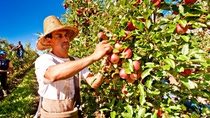Agriculture
Food Safety
Today, the safety of our food is assured through the combined efforts of all experts and regulators involved. The use of a plant protection product is only registered if the resulting exposure of the consumer to residues is shown to be less than a toxicological limit which always includes an at least 100-fold safety factor. In parallel, authorities lay down as a trade standard a maximum residue level (MRL) that must not be exceeded in treated crops.
Regular controls are conducted by official monitoring laboratories in order to ensure that the residues in food commodities remain below the MRL. When used in line with labelled instructions and according to Good Agricultural Practices, traces of Glufosinate-ammonium on crops are significantly lower than the safety threshold level.

Putting residue levels into perspective
Herbicide authorizations require manufacturers to submit data about the amounts of a product necessary to protect a crop and the residues that remain after such treatment on the harvested products. Experts evaluate the data provided and establish two acceptable levels for short term and long-term exposure to pesticide residues in the diet.
The Acceptable Daily Intake (ADI) is an estimate of the amount that can be ingested daily over a lifetime without an appreciable health risk to the consumer. The Acute Reference Dose (ARfD) estimates the amount that can be ingested during a single day without an appreciable health risk. ADI and ARfD are calculated by dividing the level of exposure to a chemical at which no adverse effect is observed by a safety factor of at least 100. Due to the high safety margin already built in this evaluation process, reaching the levels of ADI and ARfD is extremely unlikely.
For example, residues of Glufosinate-ammonium will be at levels so low, that an average person would have to consume over 250 apples in a single day in order to breach the toxicological safety threshold limits.
Did you know?
- Applied to road traffic, a safety factor of 100 would be equivalent to keeping a space of 6 km to the car in front as a safe braking distance, when driving at a speed of 120 km/h.
- Approximately 120 different tests are carried out before a product reaches the market to ensure safety and efficacy1.
- Bringing a pesticide to market takes up to ten years of research, and involves the testing of over 140,000 chemical compounds.
International trade standards
Maximum Residue Levels (MRLs) are the highest level of a pesticide residue legally tolerated in or on food or animal feed. They are often set as just a small fraction of the safety threshold level for human consumption for a substance and provide even a wider safety margin than the ADI and ARfD.
MRLs are a trade standard, regularly monitored by the relevant food safety authorities, and are intended to check that a pesticide has been applied correctly.
MRLs may vary across countries, reflecting different crops grown, climate conditions and accepted local agricultural practices. Since MRLs are not harmonized worldwide, import tolerances have been established in order to allow trade of treated commodities. An import tolerance is a MRL that is set based on uses registered in foreign countries in order to allow the import of treated commodities from abroad and facilitate international trade.
Did you know?
- Depending on the year, between 50 and 60% of the examined by the EU crops do not have any residues2, while approximately 30 – 40% have residues below the MRL level.3
- According to the US Department of Agriculture, crops that have traces of pesticide above the permitted tolerances are regularly under 1% of the examined crops in the USA.4
- Approximately 120 different tests are carried out before a product reaches the market to ensure safety and efficacy.5
Related topics
1CropLife, A Stocktaking Report: Crop Protection Stewardship Activities of the Plant Science Industry 2005-2011.
2EC. European Union Report on Pesticide Residues in Food 2006 – 2009.
3EFSA. (2013) The 2010 European Union Report on Pesticide Residues in Food.
4Pesticide Data Program. Annual Summary, Calendar Year 2010, 2011 & 2012. USDA.
5CropLife International. A Stocktaking Report: Crop Protection Stewardship Activities of the Plant Science Industry, 2005-2011.






